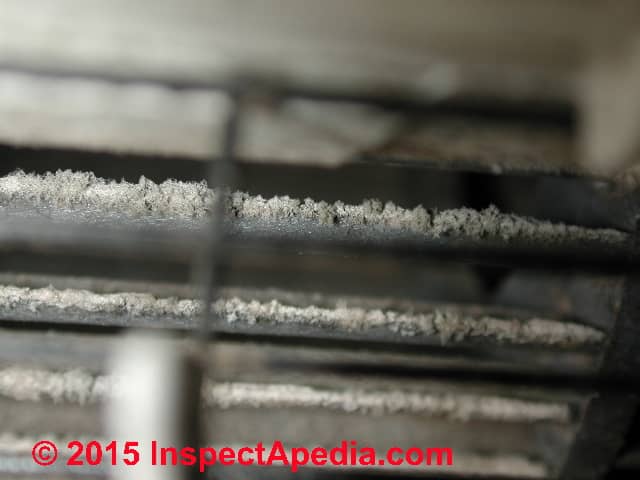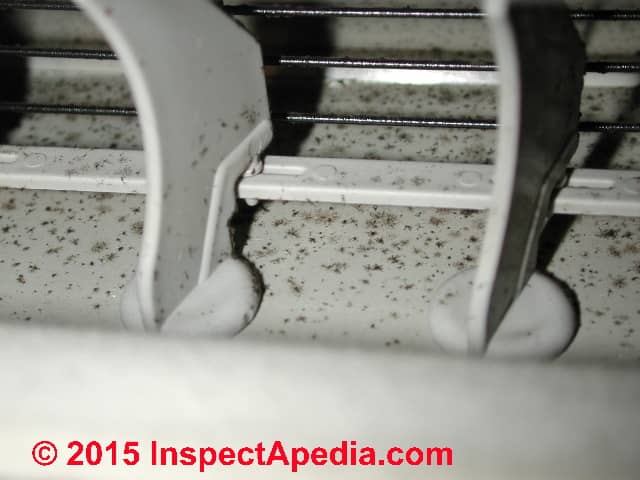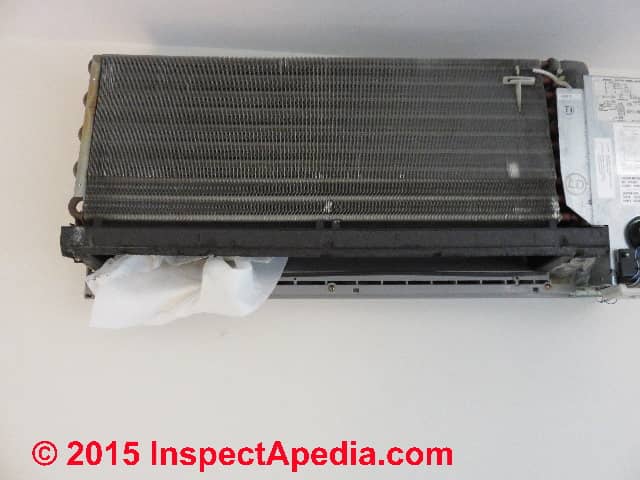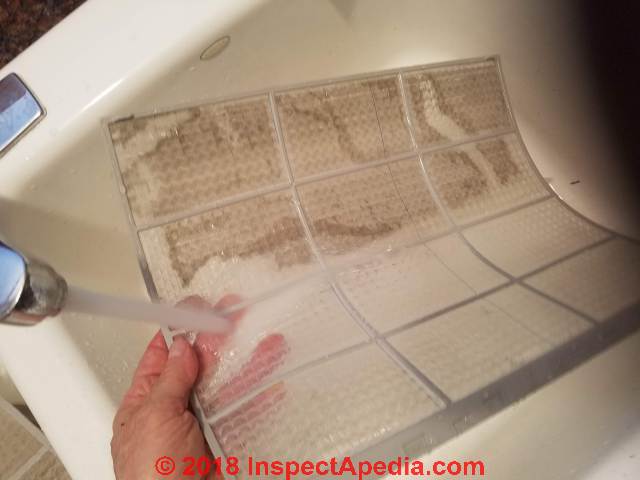 Air Conditioners & Heat Pump Air Handler Mold Removal
Air Conditioners & Heat Pump Air Handler Mold Removal
How to clean mold from a window or wall air conditioner or heat pump
- POST a QUESTION or COMMENT about cleaning a dirty or moldy air conditioner air handler or window unit or split system cooling unit
Cleaning suggestions for the indoor air handler of split system air conditioners, window air conditioners, and through-wall air conditioners & heat pumps.
This article describes simple cleaning procedures to remove mold from the air path of window or wall mounted indoor air conditioning or heat pump units.
This article series describes split system air conditioning & heat pump systems. We review the major system components, switches & controls, and typical applications for split system cooling systems. We also discuss use of the remote thermostat control, where to find and how to clean the split system air filters, how condensate is disposed-of, and what to check first if your split system air conditioner is not working properly.
InspectAPedia tolerates no conflicts of interest. We have no relationship with advertisers, products, or services discussed at this website.
- Daniel Friedman, Publisher/Editor/Author - See WHO ARE WE?
Cleaning Mold from a Wall or Window-Mounted Air Conditioner
These air conditioner mold removal steps will work on most window or through-wall air conditioners as well as on wall-mounted split system air conditioners and heat pumps.
A split system or "ductless" air conditioning (or A/C & heat pump) system dispenses with duct work entirely, using a wall-mounted indoor evaporator/blower unit and a separate outside compressor/condenser (below left and right).
At above left you can see rather typical dark mold growth on the plastic surfaces of the indoor half of a wall-mounted split system air conditioner. Similar mold may appear on window or through-wall mounted air conditioners as well.
Mold grows readily on the plastic surfaces of the air conditioner's face cover and on its air-directing louvers because these surfaces often are damp with condensate from the conditioned air.
 Mold may also grow on the metallic surfaces of the squirrel cage fan that blows room air through the air conditioner, more so as those surfaces accumulate building dust that typically includes organic debris such as skin cells.
Mold may also grow on the metallic surfaces of the squirrel cage fan that blows room air through the air conditioner, more so as those surfaces accumulate building dust that typically includes organic debris such as skin cells.
At left is a close-up of a fairly-clean split system air conditioner blower fan.
If you click to enlarge the image you'll see normal dust accumulation on the blade edges.
In contrast, if the curved blades have become dust-laden not only does that serve as possible mold food it also means that the air-flow of the blower fan will be reduced.
Don't panic if you see some black mold or dark brown mold in the blower portion of your wall-mounted split system air conditioner.
Most commonly the fungus is a member of the Cladosporium sp. family (among those samples we've tested in our lab).
Molds found in buildings may be relatively harmless, or allergenic, or sometimes more seriously harmful.
Health risks are greater for people at extra risk themselves such as asthmatics, people suffering from allergies, the elderly, infants, and people with a compromised immune system.
It is normal for dust and debris to collect on the fins of air conditioner air direction louvers, grilles, and squirrel cage blower fans.
Typically this is harmless house dust and it's not a problem until it obstructs air flow.
Below is a fairly dirty air conditioner air outlet grille or fan blade.
 But if the air conditioner is frequently wet, for example from condensate, that same dust can host the growth of a variety of molds, many of which are not highly dangerous.
But if the air conditioner is frequently wet, for example from condensate, that same dust can host the growth of a variety of molds, many of which are not highly dangerous.
However depending on the surface material that has been wet, sometimes different and more troublesome mold genera/species may grow.
And if such areas in the building are large (more than 30 sq .ft. of contiguous mold) or if harmful molds are in the air path of building air handlers such as air conditioners, professional cleaning may be in order.
See MOLD CLEANUP GUIDE- HOW TO GET RID OF MOLD if your building has a significant mold problem.
All of these surfaces can be cleaned if you work carefully to avoid damaging cooling coil fins or knocking about the wall mounted unit and its components.
You'll need some household spray cleaner (any cleaner will work but avoid using corrosive cleaners or agents on metal parts and avoid spraying your eyes). You'll also want some clean rags or paper towels and a clean soft bristle paint brush.
Remove the plastic cover for the air conditioner and for best results, use your spray cleaner, paint brush, and a garden hose sprayer outdoors to clean the cover and its louvers.
You can do that job indoors too at a large kitchen sink. Now while the air conditioner's cover is drying there is more mold cleaning to do.
Watch out: be sure that electrical power is off and disconnected from your air conditioner before removing its cover for cleaning or service. Otherwise you risk death by electrocution or cut or amputated fingers by moving parts should the equipment start while you're messing with it.
While the covers are off of the indoor air handler unit of a split system air conditioner, if you take care not to bend or damage any components, the use of a simple household spray cleaner, paper towels, and a paint brush can clean out most of the mold that likes to grow on these frequently-damp surfaces in the air conditioner's room-air path.
Using spray cleaner and dry paper towels we sprayed and wiped clean the easily-accessible areas of the wall-mounted air handler's surfaces taking care not to move, disturb, or break any louvers or other components. You can see the black mold on our paper towel at above left.
We also used a household-cleaner to wet our long soft bristle paint brush that in turn was used to gently clean the louvers of the blower fan (below).
Rinse the paint brush in clean running water, wet it again, and go back to continue cleaning the louvers of the squirrel cage blower fan until accumulated dust and debris have been removed.
 Watch out: take care not to spray or wet electrical components, and avoid spraying or wetting any fan bearings or you may be sorry you undertook this step.
Watch out: take care not to spray or wet electrical components, and avoid spraying or wetting any fan bearings or you may be sorry you undertook this step.
Watch out: if the cooling coil itself is badly soiled or blocked with dust and debris at your air conditioner or heat pump that tells us two things:
- You should as for cleaning help from a professional who can probably get the job done faster, more completely, at lower cost, and with less risk of damaging the equipment than if you mess with it yourself.
- You have not been cleaning the unit's air filter as frequently as you should.
At above-left is rather typical dark mold growth on the plastic components of a wall-mounted air conditioner.
This mold growth is small in total area, is not deserving of panic, and would be of only trivial concern were it not in the air path of an air conditioner that circulates room air.
You indeed might want to clean the system using the methods described in the article above, particularly if there are building indoor air quality complaints that appear to correlate with operation of the air conditioner.
Clean the Split System Air Conditioner Filters Too
While you're cleaning up your split system air conditioner to remove mold from the blower assembly it makes sense to also remove and clean the unit's air filters.
Depending on brand and model the air filter location and removal process varies.
You may need to snap open a cover to remove the filters (like the Sanyo unit we show below), or the filter may pull out of a slot in the split system's room air unit.
In either case nearly all split system air conditioners and heat pumps use filters that are designed to be simply washed clean in warm water, dried, and returned to duty.
If we see actual mold growth on this filter we'd use a household spray cleaner that provides a dilute bleach solution, taking care to rinse the filter thoroughly to remove all of the bleach before returning the filter to service.
But in normal circumstances the filter will simply wash clean using warm water as I'm demonstrating above.
...
Reader Comments, Questions & Answers About The Article Above
Below you will find questions and answers previously posted on this page at its page bottom reader comment box.
Reader Q&A - also see RECOMMENDED ARTICLES & FAQs
How to prevent mold growth in a split system or other air conditioner
I am about to purchase a new mini split because my old one broke and has mold. Do you know of a method to prevent mold from growing in the first place? - anonymous by private email 2018/10/24
Reply:
I have not found a mold-proof air conditioner or air handler, and I often find mold growing on the organic debris that is deposited on air filters and on the plastic or metal surfaces in the air path.
Here are some things that will at least reduce the rate of mold growth in air conditioning and air handling equipment:
- Size the unit
properly so that it will properly de-humidify the building air- Watch the condensate drain
system to keep it working and to be sure excessive condensate isn't blowing past the condensate drip tray and into the duct system or for a mini split, blowing out onto the air distribution vanes- UV light for mold reduction?
Some commercial air handler service techs experiment with the addition of UV light to try to bathe mold-prone surfaces in constant UV to retard mold growth.
UV won't kill off organisms in air blowing rapidly through the air handler but it can treat AHU surfaces.
UV Light Disinfection of HVAC Ducts & Air Handlers is discussed
at AIR FILTER OPTIMUM INDOOR
Using UV light in a wide range of applications inculding the control of bacteria, mold, and algae or moss growth is also discussed
at UV LIGHT BLACK LIGHT USES- Change the air filter
or for a mini split take out and wash the air filters regularly - monthly is recommended.- Review the building for sources of abnormally high humidity, leaks, or existing mold
reservoirs - those conditions can exacerbate mold growth in various other building areas and in building mechanical equipment.
Is this stuff on my A/C air vents mold?
How do I tell if I am dealing with mold in air vents of home? - On 2020-08-02 by Chesley
Reply by (mod) -
Watch out: That looks like several kinds of mold growth - seriously contaminated and badly in need of cleaning.
See SPLIT SYSTEM AC MOLD CONTAMINATION REMOVAL
We have a moldy A/C unit and we feel sick all the time.
We live in a condo that flooded totally, rug was never pulled up.. then flooded again during charlie. water damage to walls and ceilings so obviously it hit the floor again.
Rug is 24 years old. we have brown and black mold in the ac unit. We made them totally replace the duct work because it was all torn up, and the other ac unit was trashed and full of rug and mold.
Now the new one is full of mold. obviously from the rug. IF we vacume the vacume is full of grey powder and rug etc. Clogs everything. New washer smells like mold very bad. Ac is dripping and full of brown black mold. took a tape sample, it was so wet it wouldn't stick.
We feel sick all the time. landlord won't listen. Rug is disintegrating. On 2012-03-23 by lisa
by Mod
Lisa
It sounds as if you did not have an adequate cleanup after your condo was wet from leaks. Wet carpeting needs to be removed and based on a competent survey some added cleaning is surely in order.See
...
Continue reading at SPLIT SYSTEM AIR CONDITIONERS & HEAT PUMPS - topic home, or select a topic from the closely-related articles below, or see the complete ARTICLE INDEX.
Or see these
Recommended Articles
- AIRBORNE PARTICLE & MOLD LEVELS in DUCTWORK
- ALUMINUM BUILDING MATERIAL ODORS
- DUCTWORK CONTAMINATION
- Legionella BACTERIA & HVAC Equipment
- SPLIT SYSTEM AIR CONDITIONERS & HEAT PUMPS
- SPLIT SYSTEM AC / HEAT PUMP REPAIRS
- WHY DOES MOLD GROW in INSULATION?
Suggested citation for this web page
SPLIT SYSTEM AC MOLD CONTAMINATION REMOVAL at InspectApedia.com - online encyclopedia of building & environmental inspection, testing, diagnosis, repair, & problem prevention advice.
Or see this
INDEX to RELATED ARTICLES: ARTICLE INDEX to AIR CONDITIONING & HEAT PUMPS
Or use the SEARCH BOX found below to Ask a Question or Search InspectApedia
Ask a Question or Search InspectApedia
Questions & answers or comments about split system air conditioner operation, installation, maintenance, & repair
Try the search box just below, or if you prefer, post a question or comment in the Comments box below and we will respond promptly.
Search the InspectApedia website
Note: appearance of your Comment below may be delayed: if your comment contains an image, photograph, web link, or text that looks to the software as if it might be a web link, your posting will appear after it has been approved by a moderator. Apologies for the delay.
Only one image can be added per comment but you can post as many comments, and therefore images, as you like.
You will not receive a notification when a response to your question has been posted.
Please bookmark this page to make it easy for you to check back for our response.
IF above you see "Comment Form is loading comments..." then COMMENT BOX - countable.ca / bawkbox.com IS NOT WORKING.
In any case you are welcome to send an email directly to us at InspectApedia.com at editor@inspectApedia.com
We'll reply to you directly. Please help us help you by noting, in your email, the URL of the InspectApedia page where you wanted to comment.
Citations & References
In addition to any citations in the article above, a full list is available on request.
- [2] Modern Refrigeration and Air Conditioning, A. D. Althouse, C.H. Turnquist, A. Bracciano, Goodheart-Willcox Co., 1982
- [3] Principles of Refrigeration, R. Warren Marsh, C. Thomas Olivo, Delmar Publishers, 1979
- [4] "Air Conditioning & Refrigeration I & II", BOCES Education, Warren Hilliard (instructor), Poughkeepsie, New York, May - July 1982, [classroom notes from air conditioning and Refrigeration andAir Conditioning Technology, 5th Ed., William C. Whitman, William M. Johnson, John Tomczyk, Cengage Learning, 2005, ISBN 1401837654, 9781401837655 1324 pages
- [5] "Falling Air-Conditioners Rattle Tenants", Chris Palmer, The New York Times, 2 July 2012, p. A12.
- [7] Singer brand HVAC equipment brand history: Singer was bought by & became the climate control unit of Dallas-based Snyder General Corp. (founded by a former Singer HVAC manager) in 1982. The name Singer was dropped in 1984. In 1984 Snyder General operations included Arcoaire, Comfortmaker, and McQuay. In 1991 Snyder General sold Arcoaire & Comfortmaker to Inter-City Products. In 1994 Snyder General was acquired by Hong Leong Group Malaysia. Snyder General is at 2001 Ross Avenue Dallas, TX 75201.
- [8] Lennox air conditioning and heat pump owners manuals for air conditioners, air handlers, furnaces, heat pumps, indoor air quality systems, packaged units, water heaters, zone controls and other controls such as thermostats, are provided by Lennox at http://www.lennox.com/support/manuals.asp
- [9] Troubleshooting Split System A/C or Heat Pump Noises, Fujitsu General America, Inc., 353 Route 46 West, Fairfield, NJ 07004, Tel: (888) 888-3424, Tel-Service hotline: (866) 952-8324, Email: hvac@fujitsugeneral.com, Email service: servicehvac@fujitsugeneral.com , retrieved 8/30/12, original source: http://www.fujitsugeneral.com/troubleshooting.htm [copy on file as Troubleshooting Fujitsu Ductless Mini-Splits.pdf]
- [10] Fujitsu Room Air Conditioner, Wall Mounted Type, Heat & Cool Model (Reverse Cycle) [Heat pump units] Operating Manual, Models: ASU18RLXS ASU24RLXS ASU30RLX (indoor & outdoor units). Fujitsu General America, Inc., 353 Route 46 West, Fairfield, NJ 07004, Tel: (888) 888-3424, Tel-Service hotline: (866) 952-8324, Email: hvac@fujitsugeneral.com, Email service: servicehvac@fujitsugeneral.com , retrieved 8/30/12, original source: http://www.fujitsugeneral.com/PDF_06/Operation Manual/%28OM%29ASU18-24RLX-30RLX.pdf [copy on file as FujitsuASU18-24RLX-30RLX.pdf]
- In addition to citations & references found in this article, see the research citations given at the end of the related articles found at our suggested
CONTINUE READING or RECOMMENDED ARTICLES.
- Carson, Dunlop & Associates Ltd., 120 Carlton Street Suite 407, Toronto ON M5A 4K2. Tel: (416) 964-9415 1-800-268-7070 Email: info@carsondunlop.com. Alan Carson is a past president of ASHI, the American Society of Home Inspectors.
Thanks to Alan Carson and Bob Dunlop, for permission for InspectAPedia to use text excerpts from The HOME REFERENCE BOOK - the Encyclopedia of Homes and to use illustrations from The ILLUSTRATED HOME .
Carson Dunlop Associates provides extensive home inspection education and report writing material. In gratitude we provide links to tsome Carson Dunlop Associates products and services.






